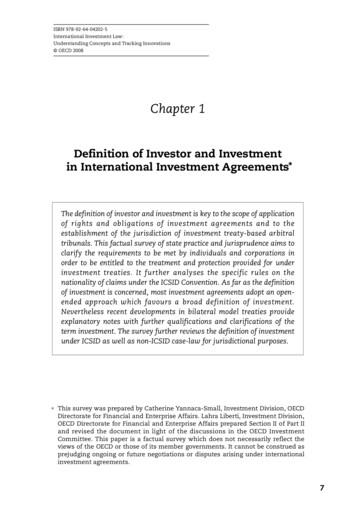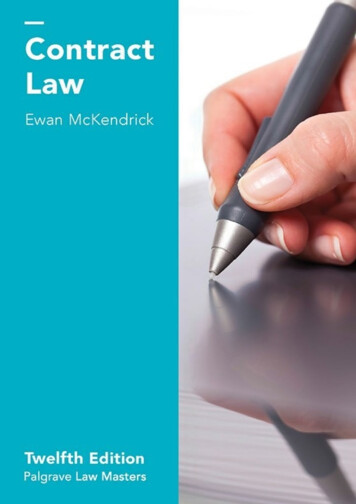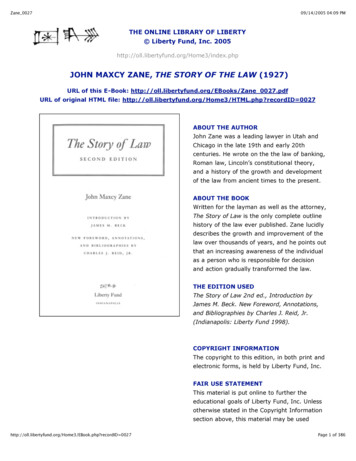
Transcription
ISBN 978-92-64-04202-5International Investment Law:Understanding Concepts and Tracking Innovations OECD 2008Chapter 1Definition of Investor and Investmentin International Investment Agreements*The definition of investor and investment is key to the scope of applicationof rights and obligations of investment agreements and to theestablishment of the jurisdiction of investment treaty-based arbitraltribunals. This factual survey of state practice and jurisprudence aims toclarify the requirements to be met by individuals and corporations inorder to be entitled to the treatment and protection provided for underinvestment treaties. It further analyses the specific rules on thenationality of claims under the ICSID Convention. As far as the definitionof investment is concerned, most investment agreements adopt an openended approach which favours a broad definition of investment.Nevertheless recent developments in bilateral model treaties provideexplanatory notes with further qualifications and clarifications of theterm investment. The survey further reviews the definition of investmentunder ICSID as well as non-ICSID case-law for jurisdictional purposes. This survey was prepared by Catherine Yannaca-Small, Investment Division, OECDDirectorate for Financial and Enterprise Affairs. Lahra Liberti, Investment Division,OECD Directorate for Financial and Enterprise Affairs prepared Section II of Part IIand revised the document in light of the discussions in the OECD InvestmentCommittee. This paper is a factual survey which does not necessarily reflect theviews of the OECD or those of its member governments. It cannot be construed asprejudging ongoing or future negotiations or disputes arising under internationalinvestment agreements.7
1.DEFINITION OF INVESTOR AND INVESTMENT IN INTERNATIONAL INVESTMENT AGREEMENTSExecutive summaryThe definition of investor and investment are among the key elementsdetermining the scope of application of rights and obligations underinternational investment agreements.There are two types of investors: natural and legal persons. For naturalpersons, investment agreements generally base nationality exclusively on thelaw of the state of claimed nationality. Some investment agreements alsointroduce alternative criteria, such as a requirement of residency or domicile.The issues related to the nationality of legal persons are more complicated.Companies today operate in ways that can make it very difficult to determinenationality. Tribunals have usually adopted the test of incorporation or seatrather than control when determining the nationality of a juridical person,unless the test of control is provided for in the agreement. Accordingly, it is thegeneral practice in investment agreements to specifically define the objectivecriteria which make a legal person a national, or investor, of a Party, forpurposes of the agreement. When the objective criteria used may includeinvestors to whom a Party would not wish to extend the treaty protection,some treaties include “denial of benefits” clauses allowing exclusion ofinvestors in certain categories.The ICSID Convention, the main instrument for the settlement ofinvestor-state disputes, limits the jurisdiction of its Centre to disputesbetween one Contracting State and a national of another Contracting State. Itprovides specific rules on the nationality of claims. For natural persons, itrequires nationality to be established on two important dates: the date ofconsent to arbitration and the date of registration, and does not cover dualnationals when one of the nationalities is the one of the other ContractingState party to one dispute. The ICSID jurisprudence as to the nationality ofnatural persons is so far limited to four cases brought by dual nationals. Forlegal persons, the ICSID Convention requires nationality to be established onlyon the date on which the parties consented to submit such dispute toarbitration and allows a departure from the principle of incorporation or seat,when the Parties agree to treat a legal entity with the nationality of theContracting State as a national of another Contracting State because of foreigncontrol. A related issue is the question of the extent to which shareholders canbring claims for injury sustained by the corporation. Recent jurisprudence has8INTERNATIONAL INVESTMENT LAW: UNDERSTANDING CONCEPTS AND TRACKING INNOVATIONS – ISBN 978-92-64-04202-5 – OECD 2008
1. DEFINITION OF INVESTOR AND INVESTMENT IN INTERNATIONAL INVESTMENT AGREEMENTSdecided in favour of the right of shareholders, to be accepted as claimantswith respect to the portion of shares they own or control.There is no single definition of what constitutes foreign investment.International investment agreements usually define investment in very broadterms. They refer to “every kind of asset” followed by an illustrative butusually non-exhaustive list of assets, recognising that investment forms areconstantly evolving. The ICSID Convention does not define the terminvestment. It is, however, possible to identify certain typical characteristics ofinvestment under the Convention which have been increasingly used byarbitral tribunals: i) duration of the project; ii) regularity of profit and return;iii) risk for both sides; iv) a substantial commitment; and v) the operationshould be significant for the host state’s development.IntroductionThe definition of investor and investment are among the key elementsdetermining the scope of application of rights and obligations underinternational investment agreements. An investment agreement applies only toinvestors and investments made by those investors who qualify for coverageunder the relevant provisions. Only such investments and investors may benefitfrom the protection and be eligible to take a claim to dispute settlement.Why is the definition of investor and investment so important? From theperspective of a capital exporting country, the definition identifies the group ofinvestors whose foreign investment the country is seeking to protect throughthe agreement, including, in particular, its system for neutral and depoliticiseddispute settlement. From the capital importing country perspective, it identifiesthe investors and the investments the country wishes to attract; from theinvestor’s perspective, it identifies the way in which the investment might bestructured in order to benefit from the agreements’ protection.1This definition may also be central to the jurisdiction of the arbitraltribunals established pursuant to investment agreements since the scope ofapplication rationae personae may depend directly on what “investor” means,i.e. being an investor of a state party to the treaty is a necessary condition ofeligibility to bring a claim. In addition, the scope of application rationaemateriae depends on the definition of investment and in particular withrespect to the jurisdiction of the International Centre for the Settlement ofInvestment Disputes (ICSID), as it extends to “any dispute arising out of aninvestment”.1. B. Legum “Defining Investment and Investor: Who is Entitled to Claim?”presentation at the Symposium “Making the Most of International InvestmentAgreements: A Common Agenda” co-organised by ICSID, OECD and UNCTAD,12 December 2005, Paris.INTERNATIONAL INVESTMENT LAW: UNDERSTANDING CONCEPTS AND TRACKING INNOVATIONS – ISBN 978-92-64-04202-5 – OECD 20089
1.DEFINITION OF INVESTOR AND INVESTMENT IN INTERNATIONAL INVESTMENT AGREEMENTSThe Investment Committee, in its discussions on the interpretations ofprovisions of investment agreements, identified the definition of investor andinvestment as among the core elements of these agreements. It requested theSecretariat to undertake legal research and analysis, looking at state practiceand jurisprudence related to these issues, with a view to improving mutualunderstanding and outcomes of agreements. As a factual survey this paperdoes not necessarily reflect the views of the OECD or those of its membergovernments. It cannot be construed as prejudging ongoing or futurenegotiations or disputes arising under international investment agreements.The issue is becoming of increased relevance in the current contextwhere national security and other essential interest concerns are on the riseand the nationality and identity of an investor and the nature of aninvestment face growing scrutiny by regulators and policy makers in a numberof OECD and non-member countries, taking into account their countries’rights and obligations under international investment agreements. Thedefinition of investor and investment under these agreements is relevant inrelation to such concerns, including protecting intellectual property andpolitically motivated corporate takeovers by foreign government-controlledinvestors or sovereign investment funds.The present document responds to the Investment Committee’s request.First, this paper addresses the definition of investor by examining the way inwhich natural persons qualify as investors under both internationalcustomary and treaty law with reference to the arbitral awards that addresssuch qualification. It then looks at the criteria used by investment agreementsto qualify a legal person as an investor and the way they have been interpretedby arbitral tribunals. Second, it examines the definition of investment asincluded in international investment agreements as well as the jurisprudencearising out of the interpretation of the term “investment” included in theseagreements. In Annex 1.A1, it gives samples of a large number of investmentagreement provisions defining investment.Part I. Definition of “Investor”I. Natural personsIt is a firmly established principle in international law that the nationalityof the investor as a natural person is determined by the national law of thestate whose nationality is claimed. However, some investment agreementsintroduce alternative criteria such as a requirement of residency or domicile.The ICSID Convention requires nationality to be established on twoimportant dates: the date of consent to arbitration and the date of registration.The Convention does not cover dual nationals when one of the nationalities is10INTERNATIONAL INVESTMENT LAW: UNDERSTANDING CONCEPTS AND TRACKING INNOVATIONS – ISBN 978-92-64-04202-5 – OECD 2008
1. DEFINITION OF INVESTOR AND INVESTMENT IN INTERNATIONAL INVESTMENT AGREEMENTSthe one of the Contracting State. The jurisprudence as to the nationality ofnatural persons is so far limited to four cases brought by dual nationals.1. Customary international lawThe right to grant and withdraw nationality of natural persons remainspart of the sovereign domain. The question before tribunals has been whetherand to what extent a state can refuse to recognise the nationality of a claimant.International law practice on questions of nationality has developed primarilyin the context of diplomatic protection.In the Nottebohm case,2 the ICJ held that even though a state may decide onits own accord and in terms of its own legislation whether to grant nationalityto a specific person, there must be a real connection between the state and thenational. The Court made the following statement:“Nationality is a legal bond having as its basis a social fact of attachment, agenuine connection of existence, interests and sentiments, together with theexistence of reciprocal rights and duties. It may be said to constitute the juridicalexpression of the fact that the individual upon whom it is conferred, either directlyby the law or as the result of an act of the authorities, is in fact more closelyconnected with the population of the State conferring nationality than with that ofany other State. Conferred by a State, it only entitles that State to exerciseprotection vis-à-vis another State, if it constitutes a translation into juridical termsof the individual’s connection with the State which has made him its national.”However, in today’s circumstances of the modern world it would be verydifficult to demonstrate effective nationality following the Nottebohmconsiderations, i.e. the person’s attachment to the state through tradition,interests, activities or family ties.3 The International Law Commission’s (ILC)2. The Nottebohm case (Liechtenstein v. Guatemala), 2nd phase, Judgment of 6 April1955, 1955 ICJ Reports 4, at 23. The case concerned Mr. Nottebohm, a Germannational who resided in Gu atemala (since 1 905). In 193 9, he travelled toLichtenstein to visit his brother and obtained Liechtenstein nationality “inexceptional circumstances of speed and accommodation” in order to gain the statusof a neutral State instead of the one of a belligerent State. He returned to Guatemalain 1940 and remained there until his deportation to the US in 1943. He then tried torely on his Liechtenstein nationality to seek diplomatic protection againstGuatemala. In these circumstances, the Court said he could not assert hisLiechtenstein nationality against Guatemala where he had settled for 34 years.3. Amerasinghe comments that: “There is a distinction between diplomatic protectionand jurisdiction for the purposes of the [ICSID] Convention [E]ven if theNottebohm Case were to be used as an applicable precedent, it is arguable that aneffective link is relevant to negating the existence of nationality only in theparticular circumstances of that case, or at any rate, in very limited circumstances”in “The Jurisdiction of the International Centre for Settlement of InvestmentDisputes” (1979) 19 Indian Journal of International Law 166, 203.INTERNATIONAL INVESTMENT LAW: UNDERSTANDING CONCEPTS AND TRACKING INNOVATIONS – ISBN 978-92-64-04202-5 – OECD 200811
1.DEFINITION OF INVESTOR AND INVESTMENT IN INTERNATIONAL INVESTMENT AGREEMENTSReport on Diplomatic Protection recognised the limitations presented by theNottebohm ruling in the context of modern economic relations:“[ ] it is necessary to be mindful of the fact that if the genuine link requirementproposed by Nottebohm was strictly applied it would exclude millions of personsfrom the benefit of diplomatic protection as in today’s world of economicglobalisation and migration there are millions of persons who have moved awayfrom their State of nationality and made their lives in States whose nationality theynever acquire or have acquired nationality by birth or descent from States withwhich they have a tenuous connection.”4However, the Nottebohm principles are still useful in cases of dual ormultiple nationality when the nationality of the claimant in order to beaccepted has to be “predominant”.In the case of dual nationality, Article 7 of the ILC Draft Articles onDiplomatic Protection states:“A State of nationality may not exercise diplomatic protection in respect of a personagainst a State of which that person is also a national unless the nationality of theformer State is predominant, both at the time of the injury and the date of theofficial presentation of the claim.”5Under customary international law, a state may exercise diplomaticprotection on behalf of one of its nationals with respect to a claim againstanother state, even if its national also possessed the nationality of the otherstate, provided that the dominant and effective nationality of the person wasthat of the state exercising diplomatic protection. In this respect, customary lawhas evolved from the earlier rule of non-responsibility under which diplomaticprotection could not be exercised in those circumstances.64. ILC, “Report of the International Law Commission on the Work of its fifty-eighthSession” (1 May-9 June and 3 July-11 August 2006) UN Doc A/61/10, Chapter IV, 33.5. Draft Articles on Diplomatic Protection, ibidem, 43.6. Support for the rule of non-responsibility can be found in the 1930 HagueConvention on Certain Questions Relating to the Conflict of Nationality Laws.Article 4 provides that: “A State may not afford diplomatic protection to one of itsnationals against a State whose nationality such person also possesses.” See alsoArt. 16(a) of the 1929 Harvard Draft Convention of Responsibility of States forDamage Done in Their Territory to the Person or Property of Foreigners, (1929)23 AJIL Special Supplement 133-139. See Art. 23(5) of the 1960 Harvard DraftConvention on the International Responsibility of States for Injuries to Aliens,reproduced in (1961) 55 AJIL 548; Article 4(a) of the resolution on “Le caractère nationald’une réclamation internationale présentée par un État en raison d’un dommage subi par unindividu” adopted by the Institute of International Law at its 1965 Warsaw Session.12INTERNATIONAL INVESTMENT LAW: UNDERSTANDING CONCEPTS AND TRACKING INNOVATIONS – ISBN 978-92-64-04202-5 – OECD 2008
1. DEFINITION OF INVESTOR AND INVESTMENT IN INTERNATIONAL INVESTMENT AGREEMENTSThe Iran-United States Claims Tribunal 7 had recourse to the test ofdominant and effective nationality in that it had to determine whether aclaimant with dual US-Iranian nationality was to be regarded as predominantlyAmerican or Iranian for purposes of bringing a claim before the Tribunal. InEsphahanian v. Bank Tejarat,8 Chamber Two found that the claimant couldclaim before the Tribunal because his “dominant and effective nationality at allrelevant times [was] that of the United States and the funds at issue in the present caserelated primarily to his American nationality, not his Iranian nationality”.Nevertheless, the Chamber distinguished the case as one in which the dualnational, rather than the state, brought his own claim before the internationaltribunal against one of the states whose nationality he possessed.2. Investment agreementsSome Bilateral Investment Treaties (BITs) include a single definition of“national” which applies to both parties. Other BITs offer two definitions, onerelating to one Contracting Party and the other to the second Contracting Party.For example the Finland-Egypt BIT9 provides that the term “national” means:“a)In respect of Finland, an individual who is a citizen of Finland according toFinnish law.b) In respect of Egypt, an individual who is a citizen of Egypt according toEgyptian Law.”The US-Uruguay BIT10 defines national to mean:“a)For the United States, a natural person who is a national of the UnitedStates as defined in Title III of the Immigration and Nationality Act.b) For Uruguay, a natural person possessing the citizenship of Uruguay, inaccordance with its laws.”Some investment agreements require some link beyond nationality. Forexample, the Germany-Israel BIT11 provides in its Article (1)(3)(b), that the term“nationals” means with respect to Israel, “Israeli nationals being permanentresidents of the State of Israel”.7. The Algiers Accords resolved the hostage crisis between Iran and the UnitedStates. Pursuant to these Accords the Iran-US Claims Tribunal was establishedin 1981 in order to adjudicate claims by nationals of each country following theIranian revolution.8. Esphahanian v. Bank Tejarat (Case No. 157), Award No. 31-157-2 (29 March 1983),reprinted in 2 IRAN-US C.T.R. 157 (1983). See also Case No. A/18, 5 IRAN-US C.T.R.251 (1984).9. Finland-Egypt BIT, entered into force on 5 February 2005.10. US-Uruguay BIT, entered into force on 1 November 2006.11. Germany-Israel BIT, signed on 24 June 1974, not entered into force yet.INTERNATIONAL INVESTMENT LAW: UNDERSTANDING CONCEPTS AND TRACKING INNOVATIONS – ISBN 978-92-64-04202-5 – OECD 200813
1.DEFINITION OF INVESTOR AND INVESTMENT IN INTERNATIONAL INVESTMENT AGREEMENTSThe criterion of permanent residence is sometimes used as an alternativeto citizenship or nationality. For instance in the Canada-Argentina BIT12 theterm “investor” means “i) any natural person possessing the citizenship of orpermanently residing in a Contracting Party in accordance with its laws”.Natural persons that are covered by the Energy Charter Treaty (ECT)13 aresimilarly defined by reference to each state’s domestic laws determiningcitizenship or nationality but also extends coverage to permanent residents:“Investor” means: “a) with respect to a Contracting Party: i) a natural personhaving the citizenship or nationality of or who is permanently residing in thatContracting Party in accordance with its applicable law”.Article 201 of NAFTA equally provides in part that: “National means anatural person who is a citizen or permanent resident of a Party.”The new Canada Model FIPA which replaces the 2004 Model FIPA coverscitizens as well as permanent residents of Canada, but it expressly provides thata natural person who is a national of both contracting parties shall be deemedto be exclusively a national of the party of his or her dominant or effectivenationality. Not many investment agreements address the issue of dualnationality.14 Nevertheless Dolzer and Stevens15 say that in the absence of treatyregulation, general principles of international law would apply, according towhich the “effective” nationality of the individual would govern.163. ICSID ConventionArticle 25(1) of the ICSID Convention provides that: “The jurisdiction ofthe Centre shall extend to any legal dispute arising directly out of aninvestment between a Contracting State [ ] and a national of anotherContracting State [ ]”. With respect to natural persons, Article 25(2) of theConvention defines “National of another Contracting State” to mean:“a) Any natural person who had the nationality of a Contracting Stateother than the State party to the dispute on the date on which the parties12. Canada-Argentina BIT, entered into force on 29 April 1993.13. Energy Charter Treaty, entered into force in April 1998.14. See also the 2005 United States-Uruguay BIT, Art. 1: Investor of a Party means a Partyor state enterprise thereof, or a national or an enterprise of a Party, that attempts tomake, is making, or has made an investment in the territory of the other Party;provided, however, that a natural person who is a dual citizen shall be deemed to beexclusively a citizen of the State of his or her dominant and effective citizenship.15. R. Dolzer and M. Stevens, Bilateral Investment Treaties (Martinus Nijhoff Publishers,The Hague/Boston/London, 1995).16. Ibidem, at 34. See the 1991 BIT between Israel and Romania which in its Protocolprovides that: “With respect to physical persons – an individual who possesses bothIsraeli and Romanian citizenship who invests in Israel shall be considered asRomanian investors, under Israeli law in force, for the purposes of this Agreement.”14INTERNATIONAL INVESTMENT LAW: UNDERSTANDING CONCEPTS AND TRACKING INNOVATIONS – ISBN 978-92-64-04202-5 – OECD 2008
1. DEFINITION OF INVESTOR AND INVESTMENT IN INTERNATIONAL INVESTMENT AGREEMENTSconsented to submit such dispute to conciliation or arbitration as well ason th e d ate on wh ich th e req ues t was registered p ursuan t toparagraph (3) of Article 28 or paragraph (3) of Article 36, but does notinclude any person who on either date also had the nationality of theContacting State party to the dispute.”The ICSID Convention requires claimants to establish that they had thenationality of a Contracting State on two different dates: the date at which theparties consented to ICSID’s jurisdiction and the date of the registration of therequest for arbitration.An extension of treaty rights to permanent residents cannot extendICSID’s jurisdiction beyond nationals of Contracting States to the ICSIDConvention.17With respect to dual nationality, the ICSID Convention excludes dualnationals, if one of the nationalities is that of the host state.18In practice, investment treaty jurisprudence under the ICSID Conventionas to the nationality of natural persons is limited to four cases brought by dualnationals.The first case is Eudoro A. Olguín v. Republic of Paraguay.19 Mr. Olguín, adual national of Peru and the United States, brought a claim against theRepublic of Paraguay under the Peru-Paraguay BIT, for the treatment allegedlyreceived from the Paraguayan authorities, in relation to his investment in acompany for the manufacture and distribution of food products in Paraguay.The arbitral tribunal rejected Paraguay’s objection to jurisdiction based on theclaimant’s dual nationality by relying on the fact that Mr. Olguín’s Peruviannationality was effective, which was deemed enough for purposes of the ICSIDConvention and the BIT.In Soufraki v. United Arab Emirates,20 the claim was related to a portconcession in Dubai. When a dispute arose, Mr. Soufraki, a dual Italian andCanadian national, invoked the Italy-United Arab Emirates BIT to bring a claimbased on his Italian nationality. The Tribunal investigated his claim of Italiannationality and found that he had lost it when he acquired Canadian citizenship.17. Schreuer refers to the Report of the Executive Directors which explains theprovision of dual nationality as follows: “It should be noted that under clause a)ofArticle 25(2) a natural person who was a national of the State party to the disputewould not be eligible to be a party in proceedings under the auspices of the Centre,even if at the same time he had the nationality of another State. This ineligibilityis absolute and cannot be cured even if the State party to the dispute had given itsconsent” in “ICSID Convention: A Commentary” (CUP, Cambridge 2000).18. Amerasinghe (n. 3) at 205.19. Eudoro A. Olguín v. Republic of Paraguay, ICSID Case No. ARB/98/5, Award, 26 July 2001.20. Hussein Nuaman Soufraki v. United Arab Emirates, ICSID Case No. ARB/02/7, Award,7 July 2004.INTERNATIONAL INVESTMENT LAW: UNDERSTANDING CONCEPTS AND TRACKING INNOVATIONS – ISBN 978-92-64-04202-5 – OECD 200815
1.DEFINITION OF INVESTOR AND INVESTMENT IN INTERNATIONAL INVESTMENT AGREEMENTSThe fact that he could present certificates of nationality only provided prima facieevidence of his Italian nationality.21 The tribunal therefore held that he was notentitled to bring a claim under the Italy-U.A.E. BIT as an Italian national.22The Tribunal recognised the difference between the ease with which aninvestor may incorporate an investment in a favourable jurisdiction in order tohave the most advantageous BIT coverage and the many difficulties faced byMr. Soufraki as a natural person in proving that he had Italian nationality,when he had previously lost it:“ had Mr. Soufraki contracted with the United Arab Emirates through acorporate vehicle incorporated in Italy, rather than contracting in his personalcapacity, no problem of jurisdiction would now arise. But the Tribunal can onlytake the facts as they are and as it has found them to be.”23On 4 November 2004, Mr. Soufraki submitted a request for annulment ofthe Arbitral Award issued on 7 July 2004 because of a manifest excess of powerby the Tribunal and its failure to state reasons. The core issue was whether theTribunal could make an independent determination of the nationality of theclaimant or whether it was bound by the determination made by the Italianauthorities relying on passports and certificates of nationality issued to theclaimant. The ad hoc Committee found that the arbitral tribunal correctlystated that certificates issued by consular authorities are not binding on thetribunal’s determination of the claimant’s nationality in order to ascertain itsown jurisdiction. The presumption in favor of the existence of the Italiann ationality was not corroborated by further evidence sh ow ing thatMr. Soufraki had reacquired his lost Italian nationality.In the case Champion Trading v. Egypt, 24 US nationals who were alsofound to be Egyptian nationals were denied the right to bring a claim againstEgypt (based on the US-Egypt BIT) because of the rule in Article 25(2)a)excluding nationals having the nationality of the Contracting State Party tothe dispute. The tribunal dismissed three claims brought by these individualshareholders in the National Cotton Company (NCC), a firm involved in cottonprocessing and trading, although it affirmed jurisdiction over two related21. Soufraki, para. 63.22. An interesting argument was raised by the defendant but was not elaborated bythe Tribunal: had Mr. Soufraki qualified as an Italian national, would he still needto meet a further test of “effective” or “dominant” nationality under internationallaw? Such a test might have required that, as a dual passport-holder, hedemonstrate that he had closer or more “effective” ties with the “home” Stateunder whose BIT he sought to bring a claim (i.e. Italy).23. Soufraki, para. 83.24. Champion Trading Company Ameritrade International Inc., James T. Wahba, John B.Wahba, Timothy T. Wahba v. Arab Republic of Egypt, ICSID Case No. ARB/02/9,Decision on Jurisdiction 21 February 2003.16INTERNATIONAL INVESTMENT LAW: UNDERSTANDING CONCEPTS AND TRACKING INNOVATIONS – ISBN 978-92-64-04202-5 – OECD 2008
1. DEFINITION OF INVESTOR AND INVESTMENT IN INTERNATIONAL INVESTMENT AGREEMENTSclaims brought by US corporate entities, Champion Trading Company andAmeritrade International Inc., which each held larger stakes in the NCC.The individual claimants argued that the tribunal should employ theinternational law test of “real or effective nationality”, which they contendedwould show that they “have not effectively acquired Egyptian nationality”. Inthe end, the tribunal did not wholly rule out the applicability of such a test inthe ICSID context, where it would be manifestly absurd or unreasonable for aperson to be classified as a dual national, perhaps where a third or fourthgeneration individual “has no ties whatsoever with the country of itsforefathers” – and where a test of real or effective nationality might beappropriate to use in ICSID. However, the tribunal was convinced that therecould be little doubt that the claimants in this case had sufficient ties to Egyptand that that they were therefore clearly excluded from ICSID arbitration. It wasrelevant that their Egyptian nationality had been used for the registration oftheir business. After dismissing jurisdicti
international investment agreements. There are two types of investors: natural and legal persons. For natural persons, investment agreements generally base nationality exclusively on the law of the state of claimed nationality. Some investment agreements also introduce alternative criteria, such as a requirement of residency or domicile.










